Tapioca crepes are naturally gluten-free and made from hydrated tapioca starch. Learn how to prepare them at home with simple steps and enjoy a light, flexible meal or snack.
Tapioca crepes are a staple in Brazilian kitchens, and you can easily make them in yours too.
Made from hydrated tapioca starch, they’re naturally gluten-free and require no flour or batter.
You don’t need to mix or knead anything, just sift, sprinkle, and cook.
The texture is soft with a gentle chew, and you can fill them with anything you like, from cheese and eggs to banana and coconut.
They cook fast and work well for breakfast, lunch, or a quick snack.
If you’re avoiding gluten or just want something different, tapioca crepes are a great option.
This guide will show you how to prepare them from scratch and help you get the texture just right.
All you need is tapioca starch, a pan, and your favorite fillings.
Related: Gluten-free Tapioca Recipes to Try
Table of Contents
- What are Tapioca Crepes?
- The Origin of Tapioca Crepes
- Ingredients You Need
- How to Make Tapioca Crepes at Home
- Best Fillings and Flavor Ideas
- Tips for Perfect Crepes Every Time
- Are Tapioca Crepes Healthy?
- How to Store and Reheat Tapioca Crepes
- Tapioca Crepes Variations Around the World
- Conclusion
- Frequently Asked Questions
What are Tapioca Crepes?
Tapioca crepes, different from cassava flour crepes, are thin, chewy flatbreads made from hydrated tapioca starch, a flour-like product extracted from the root of cassava.
Unlike traditional crepes that rely on wheat flour and eggs, tapioca crepes are naturally gluten-free and grain-free.
When cooked, the hydrated starch forms a cohesive layer that crisps slightly on the outside while staying soft and pliable inside.
You don’t need oil, milk, or eggs to prepare them, just moistened tapioca starch and a hot pan.
They are commonly filled with savory or sweet ingredients, making them a simple and adaptable meal or snack option.
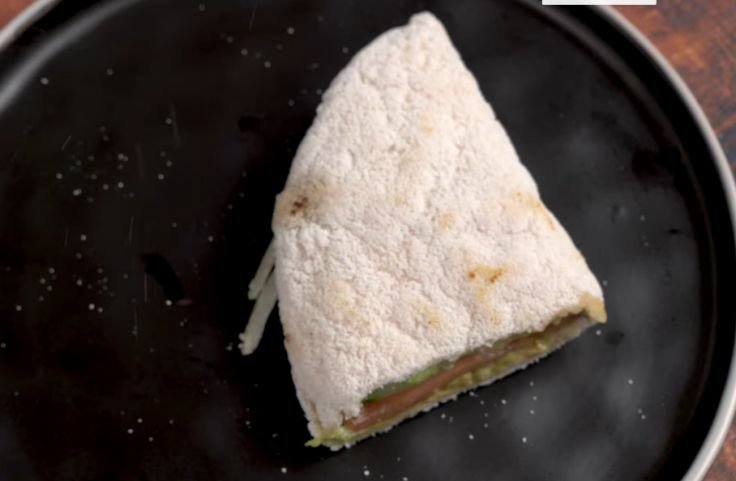
The Origin of Tapioca Crepes
Tapioca crepes have their roots in Brazil’s indigenous communities, who were among the first to use cassava as a food staple.
Cassava, also known as yuca or manioc, was ground and processed into starch long before colonial times.
This starch became the base for beiju, an early form of tapioca crepes.
Over time, Portuguese influence helped refine the cooking method, shaping the version widely eaten in Brazil today.
These crepes became especially popular in northeastern Brazil, where street vendors still serve them hot with fillings like cheese, coconut, and condensed milk.
Their simplicity and reliance on local ingredients kept them accessible, making them both a cultural tradition and a practical dish for modern kitchens.
Related Posts
Ultimate Guide To Tapioca Pearls
Are Tapioca Pearls Gluten Free?
Comprehensive Guide to Types of Tapioca Pearls
Tapioca Puffs from Cassava Starch
Ingredients You Need
Making tapioca crepes at home starts with tapioca starch. With just water and a few optional extras, you’ll be able to cook soft, gluten-free crepes ready for sweet or savory fillings.
Tapioca Starch
This is the main ingredient. Use dry tapioca starch and hydrate it yourself, or buy pre-hydrated starch called goma.
It forms the base of the crepe and gives it that soft yet slightly chewy texture when heated in a pan.
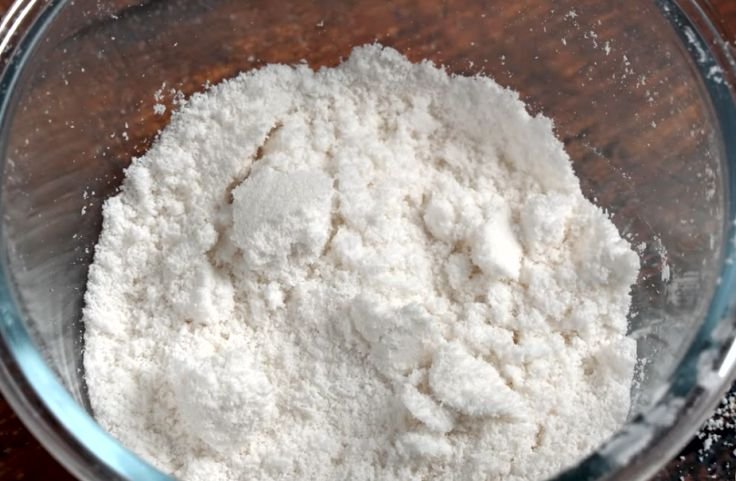
Water
If you’re using dry starch, add a little water slowly and mix until it feels like damp sand. This makes it pliable enough to cook.
Pre-hydrated starch won’t need water, so check your packaging before mixing.
Salt
A pinch of salt adds flavor to the bland starch. It’s optional but helps balance the taste, especially for savory fillings.
Add only a small amount so it doesn’t overpower the final flavor.

Savory Fillings
Cheese, eggs, seasoned meats, and sautéed vegetables are popular. Choose fillings that melt or reheat well.
Mozzarella, pulled chicken, or mushrooms work great. These turn your crepe into a full, satisfying meal.
But in this example, I used sliced cucumber, tomatoes, onions, and mayonnaise.
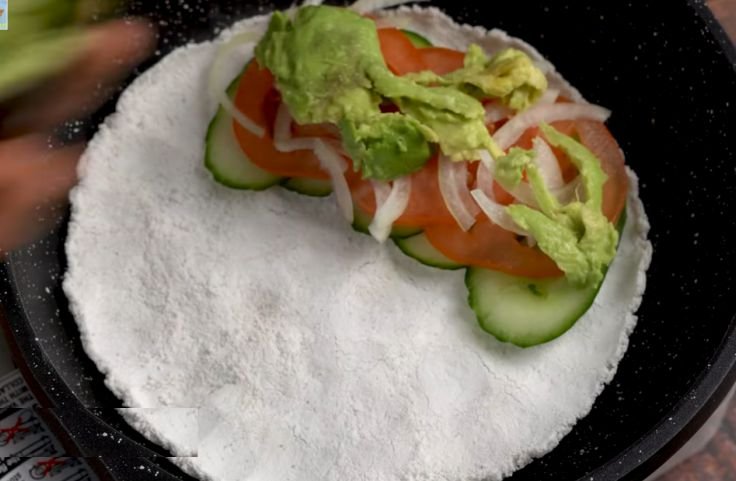
Sweet Fillings
Banana, chocolate, honey, and coconut are great choices. Spread a little hazelnut spread or condensed milk for an extra flavor boost.
These fillings make tapioca crepes a perfect dessert or midday snack.
Related: Are Tapioca Pearls Gluten-Free?
How to Make Tapioca Crepes at Home
Making tapioca crepes in your kitchen is simple and satisfying.
You only need a few steps and basic tools to turn tapioca starch into warm, chewy Brazilian-style crepes.
Hydrate your tapioca starch for the right texture
If you’re using dry tapioca starch, mix it with an equal amount of water and let it rest for about 30 minutes.
This gives the starch time to absorb the liquid and form soft, workable granules.
It should feel like wet sand that holds together when pressed. Without this step, your crepes may turn out dry or crumbly.
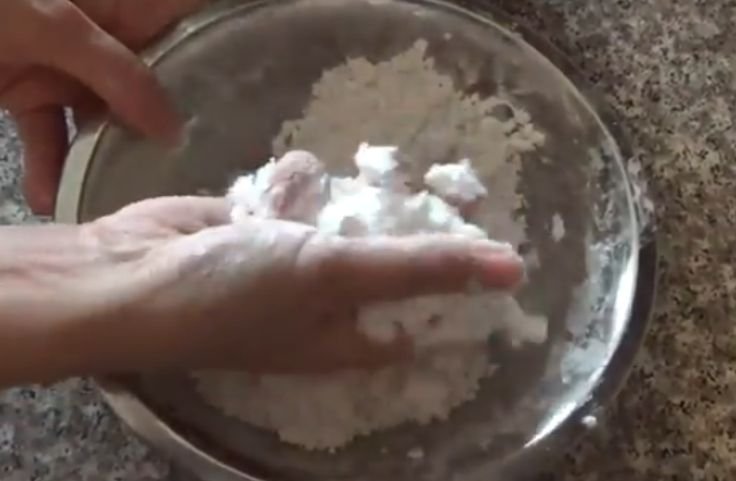
Sift the starch to remove lumps before cooking
Once hydrated, press the starch through a fine-mesh sieve directly into a clean bowl.
This breaks up clumps and helps you spread it evenly in the pan later.
Sifting also aerates the starch, giving your crepes a smooth, delicate texture when cooked.
Don’t skip this part, it’s what separates light, pliable crepes from dense ones.
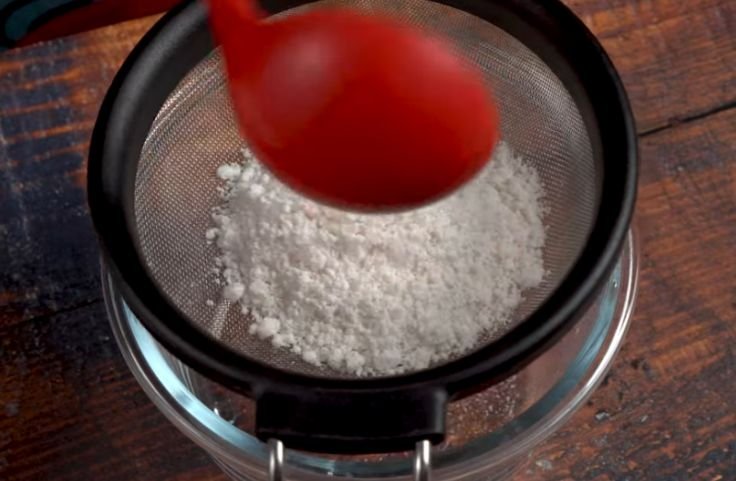
Spread a thin layer in a hot, dry pan
Place a non-stick pan over medium heat. When it’s hot, sprinkle a handful of sifted starch into the pan.
Use the back of a spoon to smooth it out into a thin, even circle. Avoid pressing too hard; you want to spread it, not compact it.
Let it cook untouched until the surface turns matte and the edges lift.
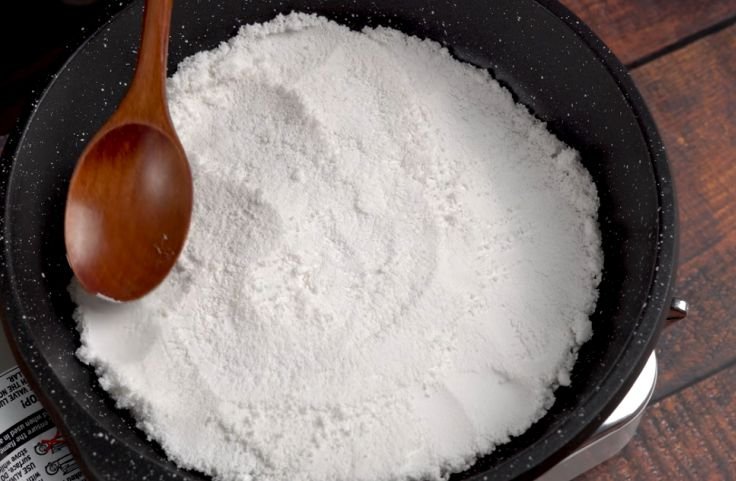
Flip gently and cook the other side
Once the edges pull away from the pan and the middle is no longer shiny, use a thin spatula to flip the crepe.
Cook the second side for another minute or two. The outside should feel slightly crisp while the inside stays soft and chewy.
You’ll know it’s done when the whole crepe holds together without breaking.
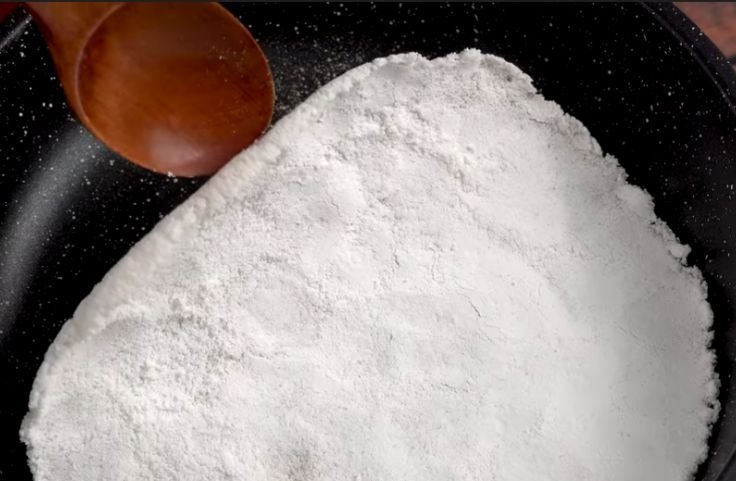
Fill and fold with your favorite toppings
Let the crepe cool slightly, then add your toppings. Try cheese and ham, scrambled eggs, avocado, shredded chicken, or banana with cocoa powder.
Fold it in half like a taco or roll it up. You can make it sweet or savory depending on your mood or meal.
It’s a quick, gluten-free option you can enjoy anytime.
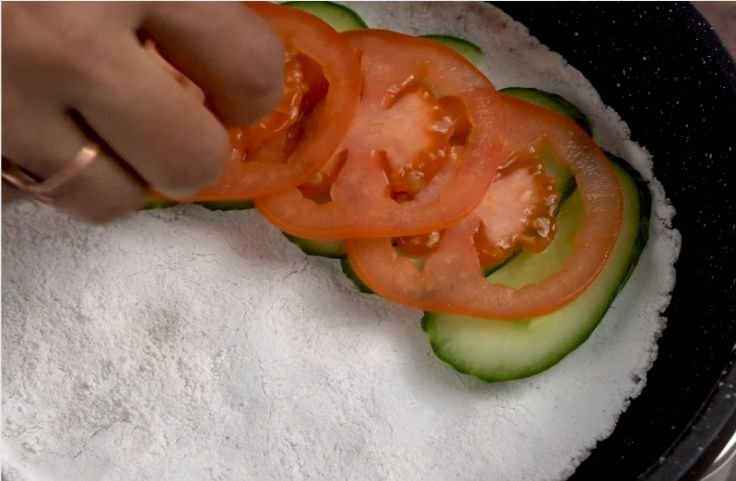

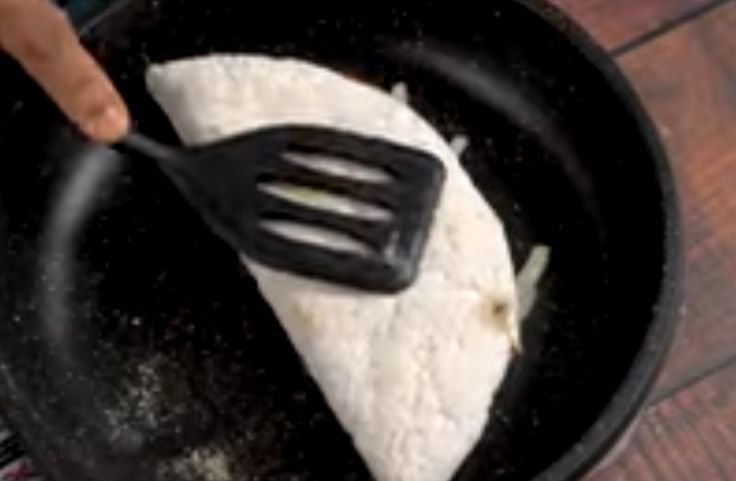
Best Fillings and Flavor Ideas
Tapioca crepes are simple to make and fun to fill. You can go sweet, savory, or somewhere in between. It all depends on what you’re craving.
Ham and cheese: a warm, salty, and melty favorite
If you want something filling and easy, you can’t go wrong with ham and cheese.
Use sliced ham and a cheese that melts well, like mozzarella or cheddar.
The contrast of salty ham with creamy melted cheese gives you that satisfying bite, perfect for breakfast or a light lunch.
Fold it in half and let the heat seal everything together.
Spinach and ricotta: light, creamy, and full of flavor
Fresh spinach sautéed with garlic pairs well with ricotta cheese. It’s soft, slightly tangy, and holds everything in place without overpowering the crepe.
This filling brings both texture and nutrients to the plate.
It’s a good choice when you want something that feels light but still keeps you full for a while.
You can also sprinkle a bit of nutmeg or black pepper to round it off.
Coconut and condensed milk: sweet, rich, and chewy
This is a classic Brazilian dessert combo. The condensed milk gives you that thick sweetness, while the grated coconut adds chewiness.
Spoon the condensed milk over the crepe while it’s still warm, sprinkle the coconut, then fold or roll it.
It’s quick to make and hits the spot when you’re in the mood for something sweet after dinner.
Fresh fruit and honey: simple, refreshing, and bright
Slice bananas, strawberries, or mango and place them inside the crepe. Add a drizzle of honey or agave syrup to bring out their natural sweetness.
This filling works well for breakfast or an afternoon snack.
The fresh fruit adds moisture and color while the syrup gives it a glossy finish that feels indulgent without being heavy.
Sauteed veggies: colorful, light, and full of bite
Bell peppers, mushrooms, onions, and zucchini work well together when lightly sautéed in olive oil.
Add a pinch of salt and herbs like oregano or thyme. This combo is great if you’re looking for something gluten-free, vegan, and full of flavor.
The natural sweetness of the veggies balances out the chewy crepe, giving you a balanced and satisfying meal.
Nut butter and fruit: creamy, sweet, and protein-packed
Spread almond butter or peanut butter inside your warm crepe, then layer it with sliced bananas or apples.
This filling works well for breakfast or post-workout snacks.
The nut butter melts slightly and gives you that creamy texture, while the fruit adds crunch or softness depending on your choice.
It’s an easy way to stay full and satisfied without using anything processed.
Tips for Perfect Crepes Every Time
Making perfect tapioca crepes takes more than just mixing starch and heating a pan.
You’ll need a few tricks to avoid tearing, sticking, or ending up with something too thick.
Use a non-stick or seasoned pan so your crepes release cleanly
Pick a non-stick skillet or a properly seasoned cast iron pan. This helps prevent sticking and makes flipping easier.
If your crepes tear when lifting, your pan surface likely needs improvement.
Clean, dry, and preheat it before each round to stay consistent.
Keep the heat at medium and steady for even cooking
Too much heat can burn the starch, while too little leaves it undercooked. Start with medium heat and test with a drop of water.
If it skates gently across the surface, your pan is ready for the batter.
Stick to ½ cup of starch and spread it evenly in the pan
Scoop about half a cup of sifted tapioca starch per crepe. Use the back of a spoon to spread it evenly in a thin layer.
Thicker crepes take longer to cook, crack easily, and are harder to fold or fill later.
Adjust the moisture or heat if crepes crack or stick to the pan
If your crepes are cracking, your batter might be too dry; add a splash of water.
If they’re sticking, preheat your pan longer or grease it very lightly. Minor tweaks like these can completely change your final results.
Are Tapioca Crepes Healthy?
Tapioca crepes can be a healthy choice when made with care. Naturally gluten-free, they’re ideal for people with celiac disease or gluten sensitivity.
Since they’re made from tapioca starch, these crepes are high in carbohydrates, giving you a quick energy boost.
However, they’re low in protein and fat, so balance matters, especially if you’re watching your macros.
What makes them flexible is the filling. Add lean proteins, vegetables, or healthy fats to increase their fiber and nutrient value.
But go easy on sweet or fatty ingredients if you’re aiming for a healthier option.
The way you fill and serve them plays a big role in their overall nutrition.
If you keep the fillings light and wholesome, tapioca crepes can easily fit into a balanced eating plan.
They’re simple, satisfying, and can support your health goals when prepared with thoughtful ingredients.
How to Store and Reheat Tapioca Crepes
To keep your tapioca crepes fresh and ready to enjoy later, you’ll need to store them properly.
Let the crepes cool completely on a wire rack first to avoid moisture buildup.
Then, stack them with parchment paper between each layer and seal them in an airtight container or wrap them tightly in plastic.
Stored in the fridge, they stay good for up to five days.
If you need to keep them longer, wrap each crepe individually and freeze them in a bag or container with the air pressed out.
They’ll hold up well for about three months this way. When reheating, bring refrigerated crepes to room temperature first.
Warm them in a non-stick skillet over medium-low heat for 30 seconds per side.
For frozen crepes, thaw in the fridge overnight before reheating.
This method keeps them soft and prevents them from turning rubbery or drying out. Proper storage makes future meals quick and easy.
Tapioca Crepes Variations Around the World
Tapioca crepes may have originated in Brazil, but the use of cassava flour crosses borders.
Many cultures use cassava in traditional dishes, shaping it to reflect their local tastes, textures, and traditions.
Colombia: Arepa de Yuca Brings a Hearty Take on Cassava
In Colombia, cassava is turned into arepa de yuca, a thick, chewy flatbread that is either baked or grilled.
Unlike thin tapioca crepes, arepas are dense and filling. They are usually served warm, stuffed with cheese, or paired with meats.
This version of cassava showcases a more rustic approach, providing comfort and satisfaction in every bite.
The texture is crisp on the outside and soft in the center, making it ideal for savory meals.
If you enjoy bold flavors and want a break from the typical crepe, arepa de yuca is a hearty alternative that holds up well to various fillings.
West Africa: Fufu and Gari Turn Cassava into Everyday Staples
In West Africa, cassava plays a central role in daily meals. Fufu is made by pounding boiled cassava into a smooth, dough-like consistency.
It’s usually served alongside soups and stews, allowing you to scoop up hearty broths with ease.
Gari is another popular option, made by grating and fermenting cassava before drying it into fine grains.
It can be eaten with hot water and sugar as a porridge or added to soups for texture.
These dishes show how cassava is more than a starch; it’s a foundation for nourishment and tradition, passed down through generations and deeply woven into local food culture.
India: Dosa Takes a Gluten-Free Turn with Tapioca Flour
Traditional Indian dosa is made with rice and lentils, but when you replace the base with tapioca flour, you get a gluten-free version that’s just as satisfying.
This alternative keeps the crispy edges and soft center that dosa lovers enjoy while catering to gluten-sensitive diets.
Paired with classic fillings like spiced potatoes or coconut chutney, the tapioca version absorbs flavors beautifully.
It’s light, golden, and ideal for breakfast or a quick snack.
This adaptation offers a great way to enjoy the familiar comfort of dosa without compromising dietary needs, blending the benefits of cassava with India’s rich spice traditions.
Southeast Asia: Kuih Snacks Turn Tapioca into Sweet and Colorful Treats
In Malaysia and Indonesia, kuih refers to a wide range of traditional snacks made with ingredients like rice flour, tapioca flour, coconut milk, and palm sugar.
These bite-sized treats are often steamed or layered, offering different textures, from soft and chewy to sticky and gelatinous.
Tapioca plays a key role in creating that signature bounce and smooth finish.
Vibrant colors from pandan, butterfly pea, and turmeric make kuih visually striking, while flavors range from sweet to slightly savory.
If you have a sweet tooth or love experimenting with texture, kuih shows just how playful and creative tapioca-based recipes can be.
Conclusion
Tapioca crepes are proof that simple ingredients can create something satisfying and adaptable.
With just starch and water, you can cook warm, chewy crepes in minutes.
Their neutral flavor means you can go savory with cheese or sweet with fruit and honey.
You don’t need fancy tools or ingredients to make them right in your kitchen. The key is hydration, proper sifting, and even heat.
Whether you’re eating gluten-free or just curious about new recipes, tapioca crepes are worth trying.
They’re light, quick to make, and easy to customize. With a bit of practice, you’ll have a go-to dish that works for any time of day.
Frequently Asked Questions
Are Tapioca Crepes Good for Gluten-Free Diets?
Yes, tapioca crepes are naturally gluten-free since they’re made from cassava starch, making them a great option for people with celiac disease or gluten sensitivity.
Can You Use Tapioca Starch Directly Without Hydrating It?
No, you need to hydrate dry tapioca starch before cooking. It should feel like damp sand to form the soft, flexible texture that crepes are known for.
Do Tapioca Crepes Need Eggs or Milk to Cook Properly?
No eggs or milk are needed. Tapioca crepes are cooked with just moistened starch and heat. This keeps them light and dairy-free, perfect for restricted diets.
How Do I Keep Tapioca Crepes from Falling Apart?
Hydrate the starch evenly, sift it well, and cook it over medium heat. If crepes crack or tear, adjust the moisture level or preheat your pan longer.
References

Chimeremeze Emeh is a writer and researcher passionate about Africa’s most transformative root crop—cassava. Through his work at cassavavaluechain.com, he explores the entire cassava industry, from cultivation and processing to its diverse applications in food, health, and industrial use.
He also writes for palmoilpalm.com, where he shares his extensive experience and deep-rooted knowledge of palm oil, covering red palm oil, palm kernel oil, and refined products. His work there reflects his lifelong connection to agriculture and his commitment to promoting sustainable value chains in Africa.
Driven by curiosity and purpose, Chimeremeze aims to shed light on how cassava continues to empower communities, strengthen food systems, and link traditional farming wisdom with modern innovation.

